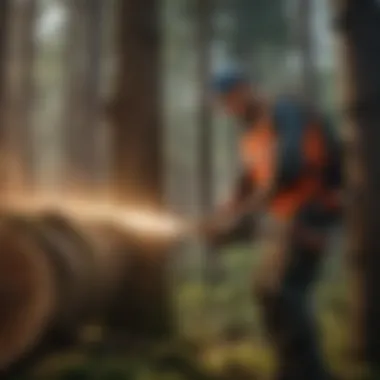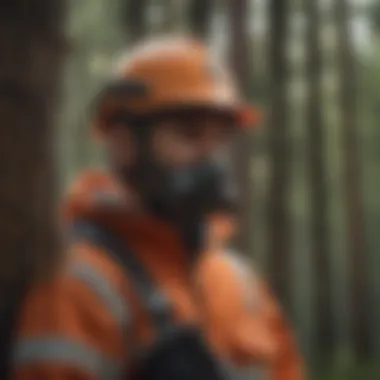Finding a Professional Tree Cutting Service


Intro
Choosing a professional tree cutting service is not merely a task; it requires careful consideration and understanding of multiple factors. Trees play a critical role in our ecosystems, contributing to biodiversity and climate health. Thus, knowing how to select the right service for tree cutting can ensure that these aspects are respected and preserved while achieving the desired outcomes for your property.
When faced with the necessity of removing trees, individuals must assess their specific needs accurately. This includes considerations for safety, the ecological impact of tree removal, and the potential for sustainable practices within the service chosen. Readers will find that grasping these essential components not only encourages informed decision-making but also promotes a sense of responsibility toward forestry management.
While evaluating potential services, factors such as certification, experience, and equipment should be scrutinized. Understanding pricing structures can also make a notable difference in budgeting an effective tree removal operation. Ultimately, this article aims to equip readers with the knowledge needed to navigate these waters with confidence, ensuring that tree maintenance and removal are handled adeptly.
Prologue to Tree Cutting Services
Tree cutting services play a crucial role in the management and preservation of both urban and rural landscapes. Understanding when and why to seek these services is essential for homeowners and landowners alike. Trees contribute to the environment in many ways, such as providing oxygen, improving air quality, and offering shade. However, there are times when tree removal becomes necessary for safety, aesthetics, or health reasons. By exploring the intricacies of tree cutting services, individuals can make informed decisions that align with both their immediate needs and long-term goals.
The process of finding a professional tree cutting service is not simple. It involves more than just choosing a company that offers low prices. There are critical factors and considerations to weigh, such as the expertise of the service providers, safety protocols, and environmental impacts. Selecting a trusted service can significantly affect the results of tree removal, including the health of the surrounding ecosystem.
Therefore, understanding the landscape of tree cutting is fundamental. It not only helps in assessing your own tree cutting needs but also in evaluating potential providers who can carry out the work. The topics explored in this article aim to offer a comprehensive overview that guides individuals in the right direction while making tree management decisions.
Understanding the Need for Tree Cutting
The necessity of tree cutting can arise from a range of factors. Identifying these needs early can prevent complications down the line. Many people may not realize that trees can pose threats. Overgrown trees can damage property or interfere with power lines, creating safety hazards. Moreover, a compromised tree may become unstable, risking collapse. Tree cutting can also enhance aesthetic appeal and encourage healthy growth in an area.
It's key to recognize signs that indicate the need for tree cutting. Discoloration of leaves or excessive leaf drop could signal underlying issues affecting the tree’s health or structural integrity.
Common Reasons for Tree Removal
Tree removal is typically driven by several common factors:
- Health Issues: Trees suffering from disease, infestation, or decay can pose risks to nearby structures and individuals.
- Safety Hazards: Trees leaning dangerously or branches that threaten to fall in high winds can cause injury or damage.
- Aesthetic Design: Homeowners might choose to remove trees to improve landscaping, create more space, or remove obstructive views.
- Construction and Development: Sometimes, tree removal is necessary to make way for new construction projects or to enhance land use for agricultural purposes.
Understanding these reasons enables property owners to prioritize tree maintenance wisely, and to seek cutting services when needed. This understanding ultimately leads to healthier ecosystems and safer living environments.
Evaluating Your Tree Cutting Needs
Evaluating your tree cutting needs is a critical step before engaging a professional service. Understanding your specific requirements can lead to more accurate estimates and a smoother process overall. Making informed decisions ensures that the trees are cut safely and effectively and that you achieve the desired result.
Identifying the Type of Tree
The type of tree you wish to remove or maintain significantly impacts the methods required and the tools used. Different tree species have unique characteristics, including height, density, and growth patterns. For example, a large oak tree requires different cutting techniques compared to a smaller pine. It's crucial to accurately identify the species of tree, as this can influence not only the cost but also the timing of the cutting. Some trees have specific seasons best for cutting, while others may present challenges due to their size or root system.
Assessing the Condition of the Tree
The overall health of a tree is another important consideration. A tree that is diseased or dying may require immediate action, while a healthy tree may only need regular maintenance. Assessing the condition involves looking for signs of rot, insect infestations, or structural instability. A professional arborist can often conduct a comprehensive assessment. Correctly diagnosing the condition of the tree can greatly impact the strategy used for removal or trimming, ensuring safety and efficiency in the process.
Determining the Location and Accessibility
The location of the tree can pose challenges as well. Trees close to buildings, power lines, or other structures will often need a more delicate approach. Accessibility is also a factor; if a tree is situated in a confined space, it may restrict the equipment that can be used. Therefore, it is essential to evaluate how accessible the tree is for cutting and whether special tools or additional personnel are necessary to ensure the job is done safely and effectively.
"Understanding your tree cutting needs is an integral part of ensuring a successful and safe tree removal process."
In summary, evaluating your tree cutting needs allows for a more systematic approach. By identifying the type of tree, assessing its condition, and determining the location's accessibility, you set a clear foundation for engaging a professional service. This not only aids in better planning but also promotes safety for both the workers and property involved.


Finding the Right Tree Cutting Service
Choosing a professional tree cutting service can significantly influence the outcome of your tree removal project. Hiring the right experts means ensuring safety, efficiency, and quality work. A trained service not only understands the intricacies of tree cutting but also adheres to safety standards that protect both the workers and the surrounding environment. Selecting the right service can be the difference between a job well done and potential hazards or damage.
Researching Local Tree Services
Investing time in researching local tree services can yield substantial benefits. Start by looking at local businesses that specialize in tree care. Online directories and search engines are valuable tools for discovering tree services in your community. Make a list of potential candidates and gather basic information about each provider, including years of operation, service range, and overall focus. Small businesses often provide personalized services. Bigger companies might offer specialized equipment or a broader range of services.
Reading Reviews and Testimonials
Once you have a list, reading online reviews becomes essential. Websites like Yelp and Google My Business provide insights from previous customers. Each review gives hints about the reliability, professionalism, and quality of service offered by the tree cutting companies. Look for common themes among reviews. Are people praising their punctuality? Do customers mention that the crews are skilled? Negative reviews should not be overlooked. They can indicate potential warning signs about services to avoid. Testimonials on company websites can be useful, but remember they may be curated. Cross-reference with independent platforms for a more balanced view.
Asking for Recommendations
Speaking with friends, family, or neighbors can uncover hidden gems. Often, personal experiences provide deeper insights than online reviews. Ask people about tree services they have used. Their direct experiences can guide you towards trustworthy providers. Sometimes local landscaping companies or nurseries may have connections to reputable tree services. Engaging these connections can lead to valuable recommendations.
Checking Certifications and Qualifications
This step is non-negotiable when considering a tree cutting service. Verify that the company holds the necessary certifications and qualifications. Look for membership in professional organizations, such as the International Society of Arboriculture (ISA). These certifications reflect a commitment to industry standards and ongoing education in tree care. Additionally, ensure the service has proper insurance coverage, which protects you from potential liabilities during the cutting process. A well-qualified service will readily provide evidence of their credentials.
Questions to Ask Potential Services
Asking the right questions when evaluating tree cutting services is paramount for ensuring that you select a qualified and reliable provider. It is not only about finding someone to cut down a tree; it is about ensuring the safety and effectiveness of the entire process. Understanding how to navigate these discussions helps you feel secure in your choice. Here are some core areas to focus on.
Inquire About Experience and Expertise
When talking with potential service providers, start by discussing their experience and expertise. This is crucial because it directly relates to the quality of work you can expect. An experienced company will have dealt with a variety of tree types and conditions, enabling them to handle unique challenges efficiently. Ask about their years in operation and the specifics of their training. Look for any professional affiliations they may have, as this often indicates a commitment to industry standards. For example, companies that are part of the Tree Care Industry Association (TCIA) tend to uphold higher service levels.
Discuss Safety Measures and Protocols
Safety should be your highest priority when it comes to tree cutting. Inquire about the safety measures that the service takes during tree removal operations. Professional services should be able to provide a clear outline of their safety protocols. This often includes wearing personal protective equipment (PPE), using safety cones or barriers, and ensuring the area is clear of bystanders. Furthermore, understanding how they handle emergency situations can underscore their commitment to safety.
Safety protocols are not just recommendations; they are essential practices that prevent accidents and injuries.
Confirm Insurance Coverage and Liability
Any professional tree cutting service must have comprehensive insurance coverage. This protects you from any liabilities that could arise during the cutting process. Ask for proof of liability insurance, and verify that it is up to date. This is not an area to overlook. If an accident happens and the service does not have insurance, you may face significant financial repercussions. Knowing they are insured gives confidence that they take their responsibilities seriously.
Request Detailed Estimates and Quotes
Obtaining a detailed estimate is vital in the service selection process. When discussing prices, focus on whether the estimates cover all aspects of the job, including labor, equipment, and debris removal. A reputable company will provide a written quote that itemizes all costs upfront. This clarity helps prevent hidden fees later. Comparing estimates from various services will also allow you to gauge average market prices, ensuring you are not overpaying for the service.
These questions help form a clear image of each potential service provider, facilitating a more informed decision as you move forward in the process.
Understanding Pricing Structures
Understanding the pricing structures in tree cutting service is crucial for making informed decisions. This aspect allows you to gauge the true cost of tree removal and maintenance while also providing you with the ability to compare various service providers comprehensively. Knowing how pricing works helps avoid any surprise costs, ensuring that you receive quality service without overspending.
Factors Influencing Cost of Tree Cutting


Several factors come into play when determining the cost of tree cutting. Understanding these elements will assist in making better financial choices:
- Type of Tree: Different species can have varying removal costs. For instance, hardwood trees like oak may cost more to cut down than softer trees like pine due to their density and size.
- Size of the Tree: Larger trees require more resources and time to cut down, which increases the overall cost. The height, width, and trunk diameter influence the complexity of the job.
- Location: If a tree is located in a hard-to-reach area or near structures, it complicates the removal. This can lead to additional costs from the need for specialized equipment.
- Health of the Tree: If a tree is diseased or damaged, it may pose extra challenges. This can increase labor time and equipment use, thus raising the price.
- Disposal Fees: Many services include debris removal in their pricing. However, some may charge extra to dispose of tree waste, especially in large volumes.
Familiarity with these factors allows homeowners to approach the process with realistic expectations regarding costs and can help in negotiations with service providers.
Comparing Estimates from Multiple Services
Obtaining and comparing estimates from multiple tree cutting services is an essential step in the hiring process. This can lead to numerous benefits:
- Price Variability: Different companies may offer different prices for the same service. Comparing multiple estimates ensures you get the best deal available.
- Scope of Services: Evaluating estimates allows you to understand what each service includes, such as stump grinding, debris removal, and even replanting. This way, you know what you're paying for.
- Identifying Red Flags: If one estimate is significantly lower than the others, it may indicate that the service provider is cutting corners or lacks experience. It's important to scrutinize these offers.
- Flexibility in Negotiation: When you have multiple estimates, you empower yourself in discussions with different service providers. You can use their offers to negotiate better terms or prices.
In summary, understanding pricing structures, recognizing influencing factors, and comparing multiple estimates will equip you with the tools necessary to navigate the tree cutting service landscape effectively. This knowledge not only fosters informed decisions but also ensures that you maximize value for your investment.
Safety Considerations
Safety is a paramount aspect when hiring a professional tree cutting service. Trees can be unpredictable in their behavior during removal, making safety protocols vital to protect both workers and surrounding environments. This section will explore key elements related to safety, including equipment evaluation and risk awareness, ensuring that readers understand how to prioritize safety when dealing with tree maintenance.
Evaluating Safety Equipment Used by Services
When considering a tree cutting service, begin by examining the safety equipment utilized by the team. Professional services should employ personal protective gear, such as helmets, gloves, safety glasses, and protective footwear. These items are crucial in preventing injuries during operations. Furthermore, workers should use specialized equipment like chainsaws, chippers, and rigging gear that are well-maintained and specifically designed for tree removal tasks.
Ask potential companies what safety gear they provide for their employees and if they conduct regular checks on the equipment. It's essential to confirm that they follow industry regulations, which often require use of ANSI (American National Standards Institute) or similar standards for personal protective equipment. This not only safeguards the workers but also minimizes risks to bystanders and property during the cutting process.
Understanding Risks Associated with Tree Cutting
Tree cutting is not without its hazards. The risks can be categorized into different types:
- Physical Injuries: Falls, cuts, or other harm can result from improper handling of tools or not adhering to safety protocols.
- Environmental Risks: Trees may fall unpredictably or cause damage to nearby structures, utilities, or landscapes if not removed with care.
- Health Risks: Dust and debris can pose respiratory issues, particularly for those with allergies or asthma.
Understanding these risks is crucial. Communicating openly with tree services about their approach to managing these hazards can provide insights into their commitment to safety. Inquire about their training protocols for employees and whether they have experience with similar tree removal tasks.
"Proper safety measures and equipment significantly reduce the likelihood of accidents during tree cutting operations."
Selecting a service that prioritizes safety helps guarantee a secure environment for all involved. By weighing these considerations, customers can protect their interests and ensure a safer tree cutting experience.
Environmental Considerations
Understanding the environmental implications of tree cutting is vital. The decision to remove trees impacts various ecological aspects, from local wildlife habitats to the broader environmental balance. Awareness of these implications ensures that individuals make informed choices that align with sustainable practices.
Assessing Ecological Impact of Tree Removal
When a tree is removed, it can create a ripple effect throughout its ecosystem. Trees serve as homes for numerous species, including birds, insects, and other wildlife. Their removal may lead to habitat destruction, pushing these species to relocate or face potential extinction. Before engaging a tree cutting service, one should consider several key factors:
- Biodiversity: Assess the types of species that depend on the tree and its surroundings. Removing a tree might disrupt food chains and create challenges for organisms that rely on that ecosystem.
- Soil Erosion: Trees play a crucial role in maintaining soil integrity. Their roots anchor the soil, preventing erosion. Without trees, areas may become prone to landslides, particularly in regions with heavy rainfall.
- Carbon Sequestration: Trees absorb carbon dioxide, helping to mitigate climate change. Cutting down trees means reducing the capacity of the environment to maintain this balance, thereby adding to greenhouse gases in the atmosphere.
By evaluating these impacts, you can gauge the long-term consequences of tree removal and potentially opt for alternatives, such as trimming or relocating trees.
Sustainable Practices in Tree Cutting


With the increasing awareness of ecological issues, sustainable practices in tree cutting have become imperative. Sustainable tree cutting ensures that the environment is preserved while meeting the needs of property owners. Some pivotal practices include:
- Selective Cutting: Instead of removing all trees in an area, this method focuses on cutting specific trees that are unhealthy or pose risks to structures. This practice enhances forest health and maintains ecosystem balance.
- Replanting: Following the removal of trees, planting new ones is essential. This practice helps restore lost habitats and contributes positively to carbon sequestration efforts.
- Use of Low-Impact Equipment: Modern equipment designed to minimize soil disturbance decreases the ecological footprint of tree cutting operations. Using lighter machinery can prevent further damage to the surroundings.
- Consultation with Experts: Engaging with forestry professionals who understand local ecosystems can lead to better decision-making. They can provide insights on the best practices for tree removal that prioritize environmental health.
"Sustainable practices are not just a trend; they are a necessity for preserving our planet for future generations."
Incorporating these practices can make a significant difference in how tree cutting aligns with ecological well-being. In the long run, these considerations will help ensure that the natural environment remains resilient and thriving.
Post-Cutting Cleanup and Maintenance
Effective post-cutting cleanup and maintenance is pivotal after tree removal. This process not only addresses aesthetic concerns but also promotes safety and ecological well-being. Debris left over from tree cutting can pose hazards, attract pests, and obstruct the area for future land use. It is essential for homeowners to prioritize cleanup to restore their environment.
Understanding Debris Removal Options
After a tree is cut down, remnants such as branches, leaves, and other debris can accumulate. Understanding the options available for debris removal is crucial. Tree cutting companies often provide various services. Here are some common debris removal methods:
- Full Cleanup Service: Many professionals offer a complete cleanup service where all debris is removed from the property.
- DIY Cleanup: Homeowners may opt to handle debris removal themselves, but will require tools like chainsaws or chippers.
- Disposal or Recycling: Some companies recycle wood into mulch or firewood, providing an environmentally friendly option.
Choosing the right method depends on the scale of work and personal preferences. Discussing these options with the service provider can lead to better decisions regarding costs and environmental impact.
Options for Tree Stump Removal
Tree stumps can be unsightly and impede land use. It’s important to consider stump removal options. There are several methods available:
- Stump Grinding: A popular option, this involves grinding the stump below ground level. It's efficient and reduces surface clutter, but can leave roots.
- Hand Removal: For smaller trees, homeowners might choose to dig out the stump manually. It requires physical effort and can be time-consuming.
- Chemical Removal: Some use chemical solutions to speed up the decomposition process. This might take longer but requires minimal physical labor.
Regardless of the method, discussing it with a professional can provide insights about what best suits the specific situation.
Planning for Replanting and Land Use
Once the tree is removed, it is crucial to consider future land use. Proper planning can ensure the area is utilized effectively. Here are some steps to consider:
- Assess Soil Health: After removal, check the soil for any damage and nutrient depletion. It may be necessary to amend it before introducing new plants.
- Consider Replanting: If the decision is to plant another tree, consider species that are suitable for the environment and local climate.
- Landscape Design: Engage with landscape architects to create a plan for optimal land use, ensuring that it integrates well within existing structures.
Taking the time to plan for replanting or other land uses leads to a more sustainable landscape while promoting ecological balance after tree removal.
Important Note: Engaging with professionals for cleanup and maintenance not only saves time but can also prevent future complications that may arise from improper tree removal practices.
Epilogue: Making an Informed Decision
In the realm of tree cutting services, making an informed decision is crucial. Understanding the various factors involved can significantly impact the outcome of your tree maintenance or removal project. A well-considered selection not only ensures safety but also fosters environmental responsibility. This conclusion aims to synthesize the key elements discussed and highlight the importance of thorough evaluation.
Weighing Your Options Carefully
When you stand at the juncture of choosing a tree cutting service, it is vital to weigh every option meticulously. Begin by revisiting all that you have learned about your specific tree cutting needs. The condition, type, location, and accessibility of the trees must be considered alongside the credentials of potential services. Short-list candidates based on their qualifications and experience. From there, you can delve deeper into their safety measures and pricing structures.
As you compare different services, look for signs of professionalism. This includes prompt communication, well-structured estimates, and a clear understanding of your requirement. Additionally, checking recent reviews or ratings can offer insight into the reliability of the companies on your list. Use this information to create a scoring system, prioritizing criteria that align with your values and needs.
The Importance of Professional Expertise
Professional expertise plays a pivotal role in tree cutting. Knowledgeable and trained personnel will not only perform the task efficiently but also ensure safety for themselves, your property, and the surrounding environment. Hiring an expert minimizes potential risks related to falling branches and incorrect cutting techniques. An experienced arborist understands how to evaluate trees properly and can make decisions that preserve the health of your landscape.
Moreover, professional tree cutting services often comply with local regulations and environmental guidelines. This approach protects the ecosystem while allowing you to achieve your tree management goals. Specific certifications and industry affiliations also serve as indicators of a service provider's commitment to staying updated with best practices. In summary, the right expertise is not merely an asset; it is essential for effective tree cutting and maintenance.
"Choosing the right tree cutting service is paramount to ensuring the longevity and health of your surrounding environment."
By reflecting on these aspects, you can confidently conclude which service aligns best with your criteria. Ultimately, this informed decision-making process sets the stage for a successful tree cutting project, retaining the beauty and safety of your outdoor space.







